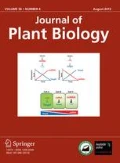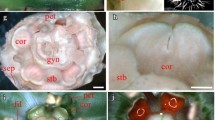Abstract
The architecture of a flower is tightly linked to the way a plant pollinates, making it one of the most physiologically and ecologically important traits of angiosperms. Floral organ development is proposed to be governed by the activity of three different classes of organ identity genes (the ABC model), and the expression of those genes are regulated by a number of meristem identity genes. Here we use a transgenetic strategy to elucidate the role of one floral meristem identify gene,LEAFY (LFY), in the evolution of floral organogenesis of a self pollinatorIdahoa scapigera and a obligatory out-crosserLeavenworthia crassa in the mustard family, Brassicaceae. By introducing theLFY genes from these two types of pollination habit into the genetic model speciesArabidopsis thaliana, we provide evidence that changes inLFY influenced flower architecture probably by controlling the downstream organ identity genes.
Similar content being viewed by others
Literature cited
Baskin JM, Webb DH, Baskin CC (1995) A floristic plant ecology study of the limestone glades of northern Alabama. Bull. Torrey Bot. Club122: 226–242
Blázquez M, Green R, Nilsson O, Sussman MR, Weigel D (1998) Gibberelins promote flowering ofArabidopsis by activating theLEAFY promoter. Plant Cell10: 801–812
Blázquez M, Soowal L, Lee I, andWeigei D (1997)LEAFY expression and flower initiation inArabidopsis. Development119: 721–743
Clough SJ, Bent AF (1998) Floral dip: a simplified method for Agrobacterium-mediated transformation ofArabidopsis thaliana. The Plant journal16: 735–743
Gailoway G, Malmberg R, Price R (1998) Phylogenetic utility of the nuclear gene arginine decarboxylase: an example from Brassicaceae. Mo! Biof Evol15: 1312–1320
Hantke SS, Carpenter R, Coen ES (1995) Expression offloricaula in single cell layers of periclinal chimeras activates downstream homeotic genes in all layer of floral rneristems. Development121: 27–35
Hofer j, Turner L, Hellens R, Ambrose M, Matthews P, Michael A, Ellis N (1997)UNIFOLIATA regulates leaf and flower morphogenesis in pea. Curr Biol7: 581–587
jack T, Fox GL, Meyerowitz EM (1994)Arabidopsis homeotic geneAPETALA3 ectopic expression: transcriptionai and posttranscripttona! regulation determine floral organ identity. Cell76: 703–716
Jofuku KD, den Boer BGW, Van Montagu M, Okamuro JK (1994) Control ofArabidopsis flower and seed development by the homeotic geneAPETAIA2. Plant Cell6: 1211–1225
Koch M, Haubold B, Mitchell-Olds T (2001) Molecular systematics of the Brassicaceae: evidence from coding plastidicmatK and nudearChs sequences. Am j Bot88: 534–544
Kyozuka j, Konishi S, Nernoto K, izawa T, Shimamoto K (1998) Down regulation ofRFL, the riceFLO/LFY homolog, accompanied with panicle branch initiation. Proc Natl Acad Sci USA95: 1979–1982
Mandel MA, Gustafson-Brown C, Savidge B, Yanofsky MF (1992) Molecular characterization of theArabidopsis floral homeotic geneAPETALA1. Nature360: 273–277
Mizukami Y, Ma H (1992) Ectopic expression of the floral homeotic geneACAMOUS in transgenicArabidopsis plants alters floral organ identity. Cell71: 119–131
Rollins RC (1994) The Cruciferae of continental North America. Stanford Univ. Press, Stanford CA.
Sessions A, Yanofsky MF, Weigel D (2000) Cell-cell signaling and movement by the floral transcription factorsLEAFY andAPETALA1. Science289: 779–781
Shu G, Amaral W, Hileman LC, Baum DA (2000)LEAFYand the evolution of rosette flowering in violet cress (Jonopsidium acaule, Brassicaceae). Am J Bot87: 634–641
Weigel D, Alvarez J, Smyth DR, Yanofsky MF, Meyerowitz EM (1992) LEAFY controls floral meristem identity inArabidopsis. Cell69: 843–859
Weigel D, Meyerowitz EM (1994) The ABCs of floral homeotic genes. Cell78: 203–209
Weigel D, Nilsson O (1995) A developmental switch sufficient for flower initiation in diverse plants. Nature377: 495–500
Yanofsky MF, Ma H, Bowman JL, Drews GN, Feldmann KA, Meyerowitz EM (1990) The protein encoded by theArabidopsis homeotic gene agamous resembles transcription factors. Nature346: 35–39
Yoon H-S, Oldham RL, Conti E, Price RA, Baum DA (2004) Molecular evolution of the transcription factorLEAFY in Brassicaceae. Mol Biol Evol, in press.
Author information
Authors and Affiliations
Corresponding author
Rights and permissions
About this article
Cite this article
Yoon, HS. A floral meristem identity gene influences physiological and ecological aspect of floral organogenesis. J. Plant Biol. 46, 271–276 (2003). https://doi.org/10.1007/BF03030374
Received:
Accepted:
Issue Date:
DOI: https://doi.org/10.1007/BF03030374




